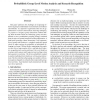Free Online Productivity Tools
i2Speak
i2Symbol
i2OCR
iTex2Img
iWeb2Print
iWeb2Shot
i2Type
iPdf2Split
iPdf2Merge
i2Bopomofo
i2Arabic
i2Style
i2Image
i2PDF
iLatex2Rtf
Sci2ools
ICCV
2011
IEEE
2011
IEEE
Probabilistic Group-Level Motion Analysis and Scenario Recognition
This paper addresses the challenge of recognizing behavior of groups of individuals in unconstraint surveillance environments. As opposed to approaches that rely on agglomerative or decisive hierarchical clustering techniques, we propose to recognize group interactions without making hard decisions about the underlying group structure. Instead we use a probabilistic grouping strategy evaluated from the pairwise spatial-temporal tracking information. A path-based grouping scheme determines a soft segmentation of groups and produces a weighted connection graph where its edges express the probability of individuals belonging to a group. Without further segmenting this graph, we show how a large number of low- and high-level behavior recognition tasks can be performed. Our work builds on a mature multi-camera multi-target person tracking system that operates in real-time. We derive probabilistic models to analyze individual track motion as well as group interactions. We show that the soft...
| Added | 12 Dec 2011 |
| Updated | 12 Dec 2011 |
| Type | Journal |
| Year | 2011 |
| Where | ICCV |
| Authors | Ming-Ching Chang, Nils Krahnstoever, Weina Ge |
Comments (0)

